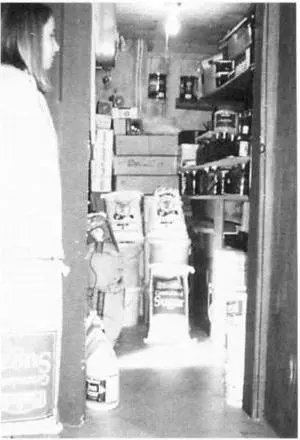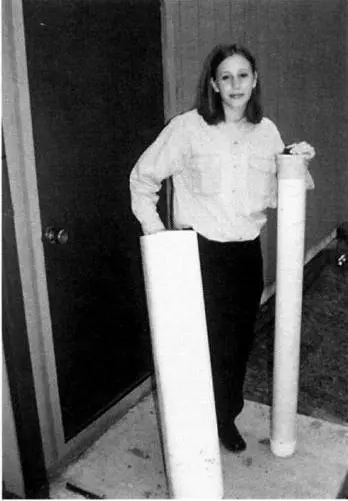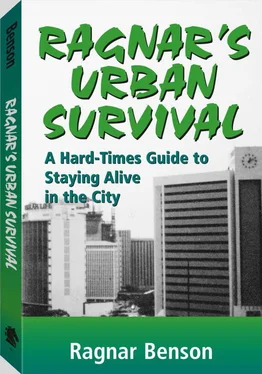Was all this risk to bomber pilots flying in with stupid-looking, anonymous silver cache tubes worth it.? In some cases we still don’t know the real names of the Resistance fighters. We do know that although tens of thousands were caught and killed (3,000 in Lidice, Czechoslovakia, alone in the massacre that was meant to avenge the assassination of SS leader Reinhard Heydrich) that absolutely no German tanks were manufactured in Occupied France, that all rail traffic within France was near impossible, that all major German troop movements were reported to the Allies, and that some experts claim Resistance-induced damage in France was greater than that done by the entire Allied Bomber Command during the same period.
Caching weapons and explosives in densely populated occupied cities, where profitable targets are many, obviously can be—and was—decisive.
Now fast-forward to Vietnam in the 1960s and very early ’70s. Here is an entire war cornerstoned on caching. Tons upon countless tons of rifles, ammunition, mines, grenades, machine guns, artillery, mortars, mortar bombs, heavy machine guns, artillery rounds, and even stuff as common as rice, bandages, cooking oil, and shoes, all carried ant-like down the Ho Chi Minh Trail, disappeared underground in South Vietnam.
U.S. GIs reported in dismay that it was completely impossible to keep vehicle inner tubes of any kind around. Viet Cong operatives surreptitiously carried them all off for use as a kind of fieldexpedient cache tube. Immediately before an engagement, all of them miraculously came out of hiding and into action. Immediately after, all went back underground or under rice paddies again.
U.S. servicemen who have returned to Vietnam during the past few years report that peasants still dredge up left-behind weapon caches in significantly large numbers. This is almost 25 years after disposition. Perhaps there is enough for another revolution, but the Vietnamese seem tired of fighting.
Significantly, at least in my mind, caching was a tactic again successfully deployed by Communists. For the second time in a century, a relatively tiny, insignificant force used the otherwise obscure device of caching critical tools and supplies till the very moment when their deployment would be decisive to win a war.
Storage can also imply hiding and secrecy, but not to the extent of caching. Traditional caches usually contain relatively few supplies. But all these supplies are absolutely critical. These may include a gun or guns, ammunition, silencers, maps, and to some extent optics, radios, and other electronic gear. These last items are much like placing medicine and medical supplies in caches.
Vietnam notwithstanding, caches usually imply long-term storage-sufficiently long that cached electronics gear, glass, and medicines are likely to go out of condition. In France it was often 5 years or more between caching and actual deployment.
Common items in city caches might include a rifle, pistol, ammo. small tent, jacket, flashlight, MREs (having better cache life than other foods), a compass, gloves, and batteries. Some other suggestions might include an aluminum cook kit, rope, magnifying glass, matches, solid-fuel tablets, a pen, paper, and vitamin tablets.
Storage is also for goods over the long term. But storage items generally include goods that are not immediately labeled as contraband, as well as larger quantities of these goods for longer term use. Storage items may also include stocks of trade goods and semiperishables that must be rotated at set intervals. This could include bags of flour or sugar, or 55-gallon barrels of gasoline. But some items, like two-cycle oil, store nicely over the long term and don’t need to be rotated.
Let the record note that both storage supplies and cache tubes will always be compromised in our technological society when it becomes politically expedient to do so. In times past, many of us spent a great deal of effort confusing storage and caching. This led to deep-storage techniques involving carefully hidden supplies sealed in plastic garbage cans. This was both a hiding and preservation technique that would have been more easily accomplished by obscurity, caution, and purchasing more suitable storable items.

Modern rat and mouse poisons are miraculous in their ability to control vermin around shelf-stored food.

Keeping your supplies clean, dry, and safe from pests will be of vital importance.
In that regard, boxes of medical supplies, sealed bags of dried peas, lentils, beans, rice, oil, and salt can more simply be stored on well-built steel or wooden shelves placed in an obscure but dry temperature-controlled portion of an apartment, garage, or basement. About the only real precaution is to keep these goods from rats and mice and from exposure to casual view.
For the first time in recorded history, rats and mice are controllable. Modern, scientifically formulated rat and mouse poisons allow us to store bags of commodities in the open on shelves. Modern rodent poisons are even taste-tested. Rats and mice consume it in preference to anything else, and mortality in the group doesn’t produce bait shyness.
As mentioned, purchasing cleaned, treated, sealed bags of commodities rather than raw, farm-run grain, wheat, or dried peas and beans takes care of a great many potential problems. All dirt, chaff, vermin, and whatever have been cleaned from these commodities and, rather than dealing with farmers, this stuff can be purchased at the local grocery.

Sturdy cache tubes can be made using 4- and 8-inch SDR pipe.
As much as we don’t want to admit it, modern technology makes it possible to find virtually any cache, whenever it is politically expedient to do so. In contrast to World War II and even Vietnam, when modern, super-sensitive underground metal detectors were first coming into use, it is relatively easy to uncover a cache tube today, especially out in the country. That’s the bad news. The good news is that it is dramatically easier and less expensive to construct and hide an effective cache.
Almost all cache tubes are put underground, underwater, or under something. I especially like cache locations under roads. Blacktop and rural gravel roads are especially easy to dig for cache tubes.
During World War II, aluminum cache tubes hidden in salt water were ruined in as little as 4 months: they easily became crinkled, damaged, and leaky, most quickly losing their seal. Currently, cheap, easy-to-use cache tubes can be safely placed just about anywhere. I recently saw one that was kept in a fireplace wrapped in heavy reflective foil and rock wool.
Cache tubes can be made at home using SDR (sanitary drain, refuse) plastic pipe, available in virtually any full-service plumbing shop. In the 4-inch size, there is a heavyweight and lightweight grade. Six- and 8-inch tubing comes only in heavy and extra heavy grades. Because of price and portability, first-time cachers generally try to get by on 4-inch tubes. Eventually, everyone comes ’round to using 8-inch pipe.
An 8-inch cache tube 60 inches long will hold a real load of stuff! Eight-inch tubes hold at least two full-sized rifles, four assault rifles, four or five pistols, and several dozen magazines. These magazines can be loaded two-thirds full, or loose rounds can be dropped in as a kind of packing. Other previously mentioned items such as tents, road tarps, MREs, and flashlights might also go in the tubes, depending on one’s circumstances. Some of these tubes get up around 200 pounds each when packed, perhaps arguing for smaller, more portable tubes. Smaller tubes are not generally considered because of their inability to hold some bulky rifles.
Читать дальше














